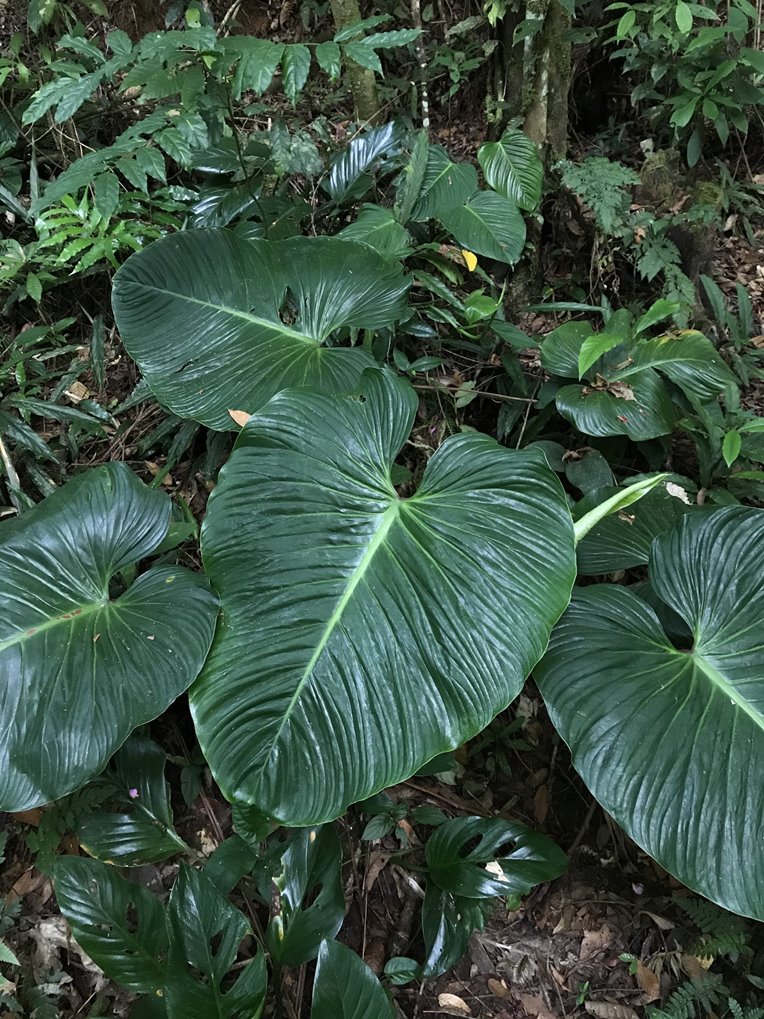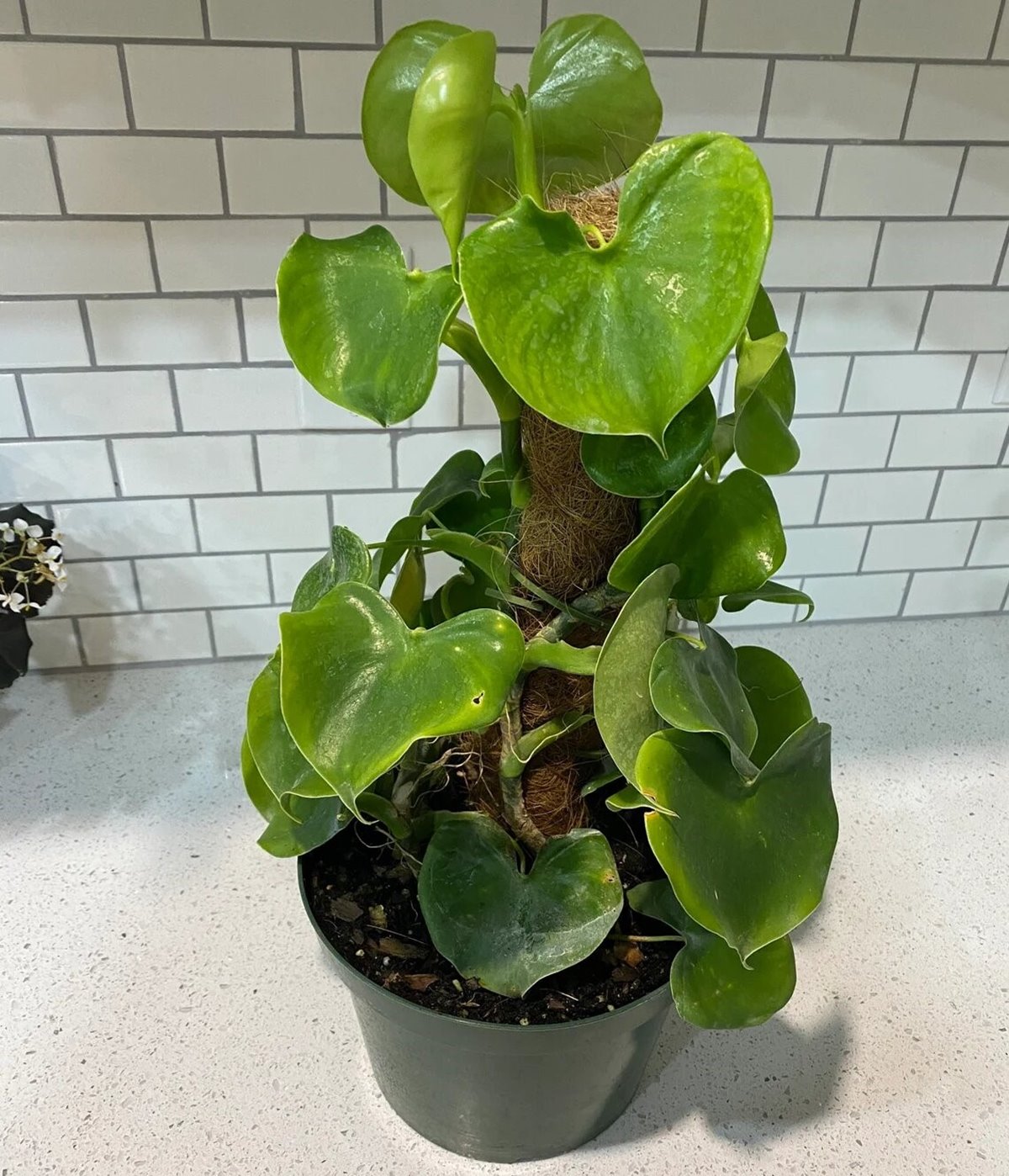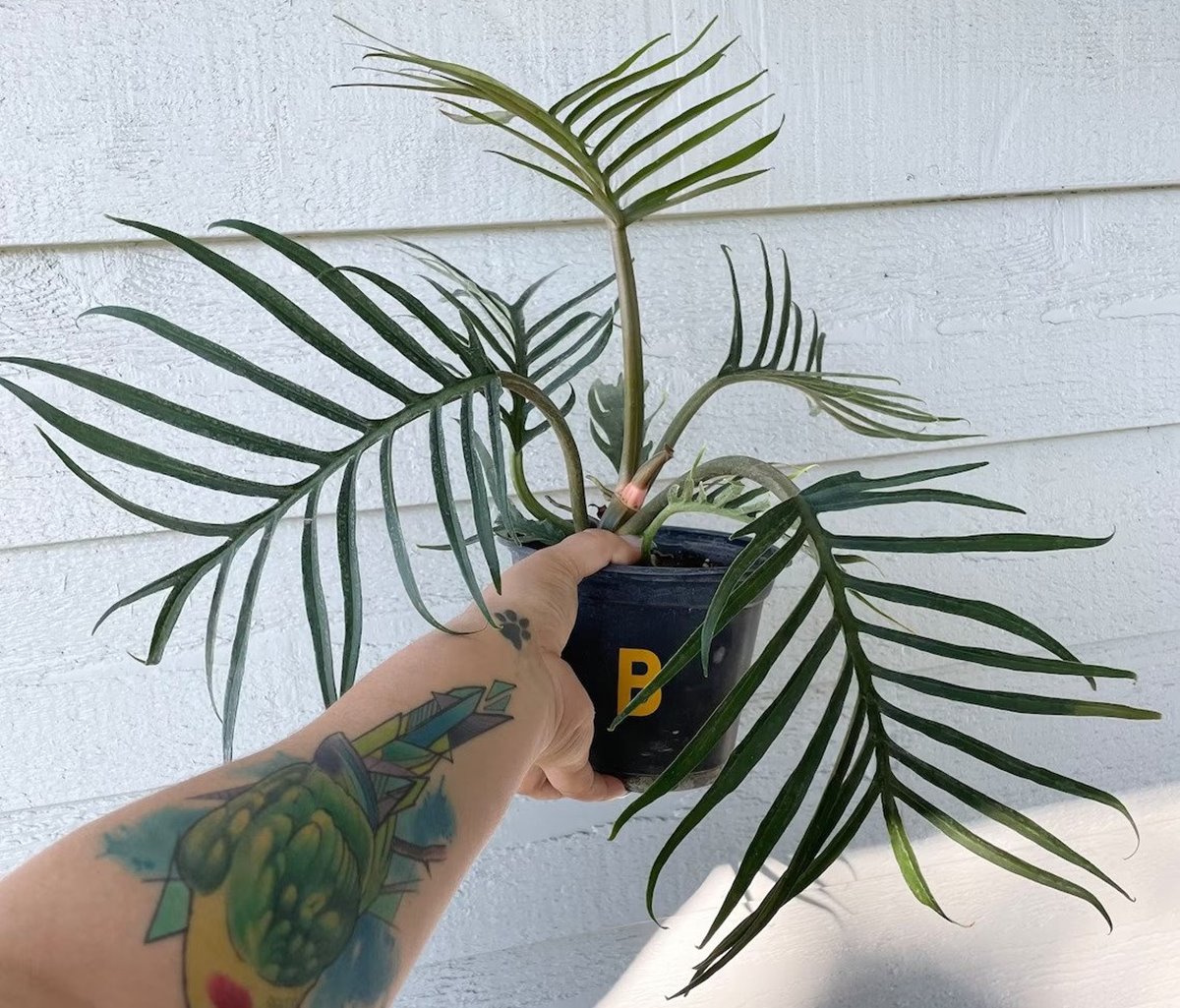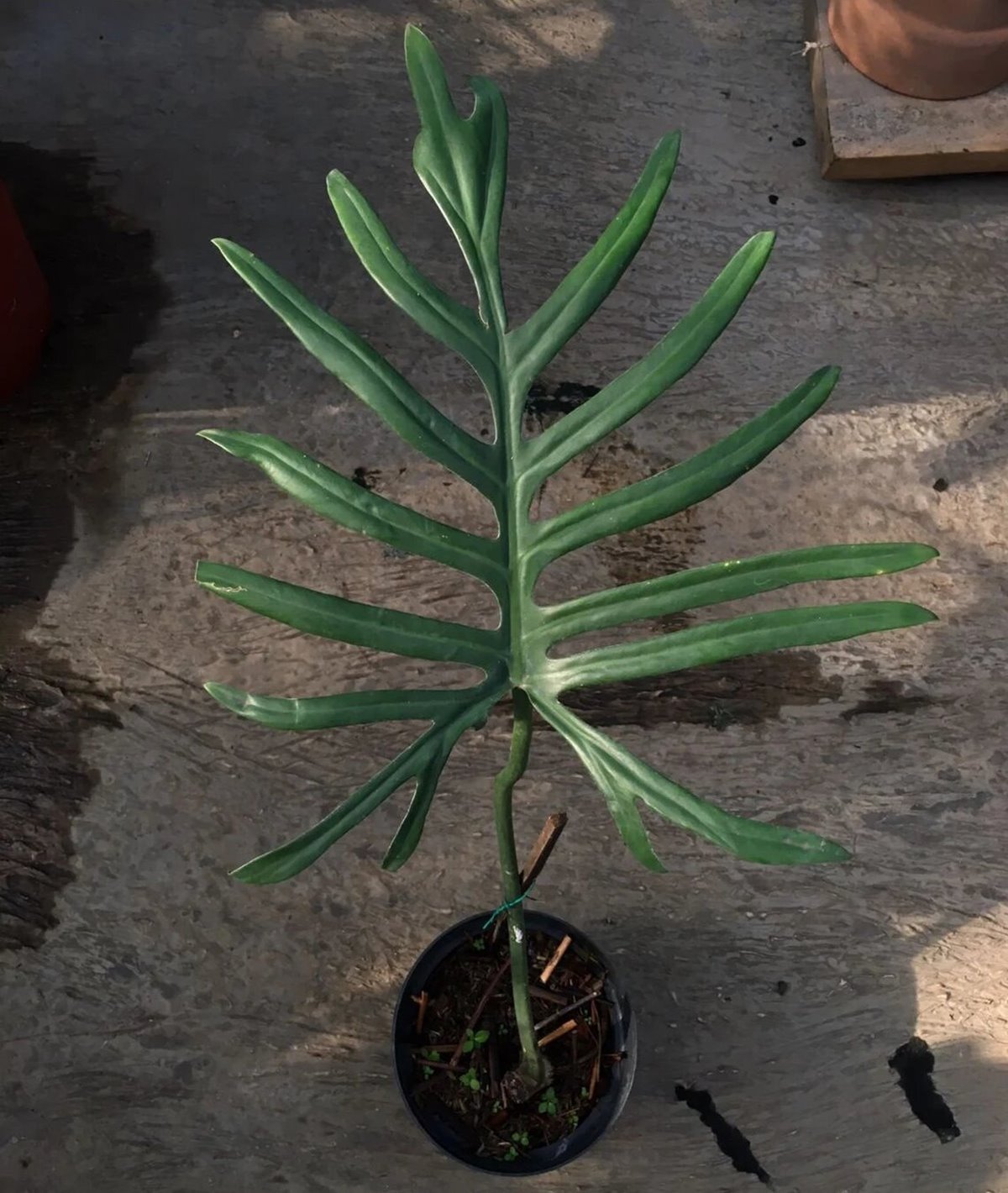Philodendron ornatum is a rare or uncommon evergreen climbing plant native to Trinidad-Tobago to tropical South America. We bet you will love its lovely large, glossy green leaves with a light-green margin, midrib, and primary veins. Did you know it is also air purifying?
Learn more about P. ornatum, including its appearance (leaves, stems, or flowers) and care (humidity, light, temperature, watering, fertilizer, etc.). We will also look at propagation and problems (pests, disease, leaf discoloration, etc.).
Note: Many vendors often mislabel or mistake this aroid for silver leaf Philodendron (Philodendron brandtianum) or sodiroi ornatum silver (Philodendron sodiroi). But these are different plant species.

Contents
Quick overview
- Scientific name: Philodendron ornatum
- Family: Araceae (arum family or aroids)
- Native habitat: Trinidad-Tobago to Tropical South America
- Toxicity: Toxic to humans, cats, dogs, and other pets, Why? Because it has insoluble calcium oxalates.
- Care level: Easy
Description and appearance?
What does this aroid look like (leaves, stems, flowers), and what are its growing habits?
Growing habits
Philodendron ornatum is an evergreen climbing hemiepiphyte. A hemiepiphyte is a plant with one phase as an epiphyte (growing on host trees) and the other terrestrial (ground). Such plants rarely grow entirely on the ground or as an epiphyte.
This adorable plant is native to Brazil (North, Northeast, and Southeast), Ecuador, Bolivia, French Guiana, Peru, Suriname Guyana, Venezuela, and Trinidad-Tobago. It grows on moist tropical low land and montane forests above 656 feet (200 m) from the sea level and mainly on sandy soils (Mata de baxio).
Lastly, the juvenile and mature forms look different. For instance, the juvenile has smaller teardrop-shaped leaves while a mature plant will have larger, heart-shaped leaves and forms a rosette.
2. Growth rate and size
P. ornatum is a relatively fast-growing aroid that needs a climbing place to transform into an adult form. It may grow up to 4 to 6 feet or more at home.
3. Leaves
P. ornatum leaves vary significantly in juvenile and mature flowering plants. Also, new leaves are coppery gold but turn green as they mature.
The juvenile plants have small, teardrop green leaves. Mature P. ornatum, on the other hand, will have large, 5.9-19.7 inches (15-49.7 cm) long by 5.9-14.3 inches (15-36.4 cm) broadly heart-shaped, ruffled, nearly membrane-like glossy green leaves with light green margins and a light green underside. Also, the midrib is lighter, and the underside’s lateral veins are reddish when still new.

That is not all. The juvenile petiole is shorter, while those in mature plants are longer. The petiole of mature plants is convex on the upper side with angular margins and rounded beneath. These leaf stalks have dispersed, extrafloral purplish nectaries, a wine-colored apex, and warty-like growths. Also, their sheath is inconspicuous.
Lastly, their persistent prophylls are pinkish as the leaves emerge but will wither, turning brownish or gray-brown membranes then fibers.
4. Stems and roots
Stems are greenish in young plants and have longer internodes. In mature plants, stems are green-brownish, slightly thicker, and have shorter internodes.
Lastly, roots are reddish in young plants and brown in mature plants.
5. Flowers
Philodendron ornatum has 1-3 inflorescence per axil with a spadix and spathe. The peduncle is shorter than the spathe.
The spathe has a constriction separating the blade and the tube, which is pink to carmine on the inner side and light green outside. The blade, on the other hand, is light green outside and pink inside. Both have resin canals.
Lastly, the spadix has the lower female section, a middle sterile male with a slightly thicker base, and the upper fertile male area.
Philodendron sodiroi x ornatum
We have seen some people selling a Philodendron sodiroi x ornatum hybrid. We cannot comment more on the hybrid plant. Also, at the moment we don't know if it is authentic.
Philodendron ornatum care
P. ornatum requires a warm, humid area with bright indirect light. Keep the soil moist, allowing it to dry slightly before watering, and feed it once a month.
Here are the P. ornatum care and growth requirements
- USDA hardiness zone: 10-11, not frost hardy, and prolonged freezing will cause damage.
- Humidity: Provide moderate to high humidity, 50% or more. If your household humidity is low, buy a humidifier, have a pebble tray, or move it to more humidity rooms. Misting will only help solve the problem temporarily.
- Temperature: Maintain an ideal temperature of 65 to 85 degrees Fahrenheit (18-29°C). Avoid temperatures below 55°F (12.8°C), sudden temperature changes, or cold drafts. Also, don’t place it near air conditioning vents, heating vents, or heat sources.
- Light: They grow best in bright, indirect light but can survive moderate light. Avoid too little light or direct sunlight.
- Soil: Give them chunky or airy, slightly acidic to neutral, well-drained soils high in organic matter. Buy an aroid mix from places like Etsy.com or add perlite, peat moss, and bark chips to your potting mix to make it well-draining.
- Watering: Water when the top few inches feel dry or up to your 1st finger knuckle. Also, you can use soil moisture meters to know when to water. XLUX is such a good brand.
- Fertilizer: Feed once a month in growing months with a balanced, liquid fertilizer for houseplants such as Miracle-Gro Indoor Plant Food (Liquid). Alternatively, you can use a balanced, slow-release formula for houseplants, But follow what manufacturer says.
- Pruning and grooming: Cut any dead, damaged, or diseased leaves or parts with a sterilized pruning scissor and wipe leaves when they are dirty or dusty. In the growing season, you can cut back stems (no more than 25% at a time) to control growth or size.
- Repotting: Repotting is after 2-3 years or when rootbound. Use a pot 2-3 inches wider in diameter and do it in growing months.
- Staking: Provide and train your plant on a moss pole, trellis, totem, or any place to climb.
Philodendron ornatum propagation
Philodendron ornatum propagation is by stem cutting or air layering. We recommend doing it in spring or early summer. Why? Because the plant needs to establish itself before non-growing months.
If you opt for stem cutting, you need to find a healthy stem with at least a node or two and cut it just below the lower node. Use a sterilized pruning knife or scissors. Afterward, you can apply your rooting hormone and plant it. Then place it in a warm, humid area with bright, indirect light and ensure you keep the soil moist.
If you prefer water propagation, put the cutting in water. Then replace the water after every 3-4 days.
Air layering will involve tying moist sphagnum moss with a plastic bag around a node on a selected stem without cutting it from the mother plant. Remember to poke holes in the plastic bag for aeration and keep the sphagnum moss moist. Once the node has rooted well, you can cut and transplant it.
Common problems
- Pests: Your plant may have spider mites, aphids, thrips, or scale insects, but they are uncommon. Use neem oil, horticultural oil sprays, and insecticidal soaps to manage them in case of any.
- Diseases: This Philodendron may have fungal and bacterial leaf spots characterized by brown lesions. But like pests, they are uncommon. Isolate new plants, practice proper hygiene and isolate and treat affected plants.
- Root rot: Prevalent in overwatered P. ornatum or those with compactable, poorly draining soils. If not all the roots have turned black or mushy, remove the decayed parts with sterilized gardening scissors and repot the plant.
- Leaves turning yellow: Most likely indication of overwatering. But underwatering, low humidity, too little light, or nutritional deficiencies may cause the yellowing.
- Brown tips and edges: Brown tips and edges are a sign of underwatering, heat stress, too much light, low humidity, repotting stress, etc.
- Leaves curling: Underwatering, too much light or low humidity, or anything that causes moisture issues.
- Leaves drooping or wilting: The main causes are moisture issues, low humidity, heat stress, or anything that prevents water absorption or increases loss.
Where to find Philodendron ornatum on sale
P. ornatum is a rare and hard-to-find plant. If you need it, Etsy.com and eBay should be your first choice. You may be lucky to get vendors in your region, i.e., the UK, US, Australia, Canada, etc.
The other places are Instagram and Facebook plant groups. Also, you can google for "Philodendron ornatum for sale" to see if you can get any vendors online.
FAQs
Yes. Philodendron ornatum is a rare or uncommon houseplant. You will find trouble finding it not just at your local tropical plant stores but also online. Of course, the big box companies or horticultural growers don’t have it.
The price of Philodendron ornatum is $25 to $100 for a cutting to a rooted plant. But we have seen someone selling it as high as £129.00 (USD 170) at eBay UK





Leave a Reply